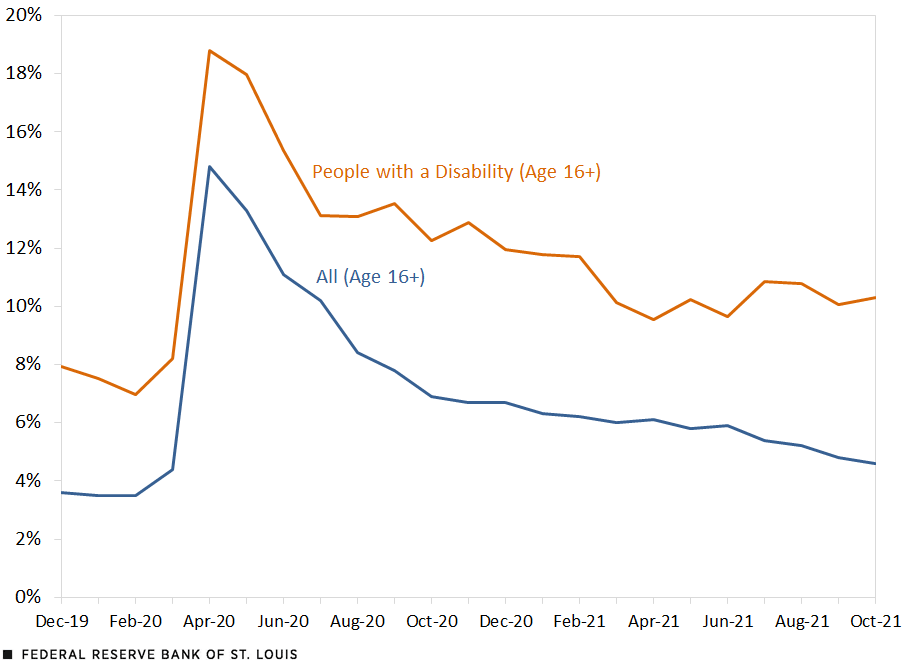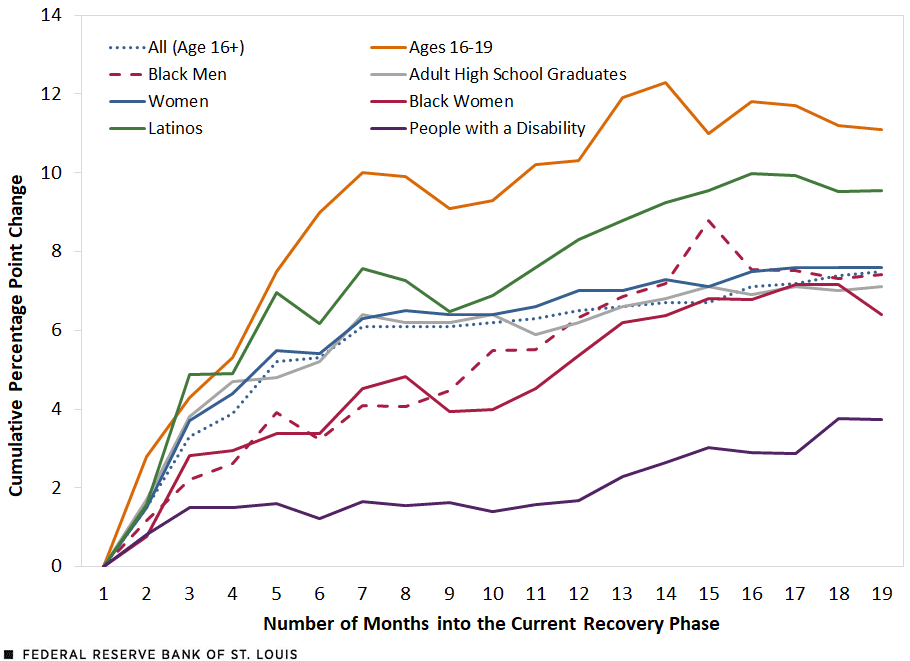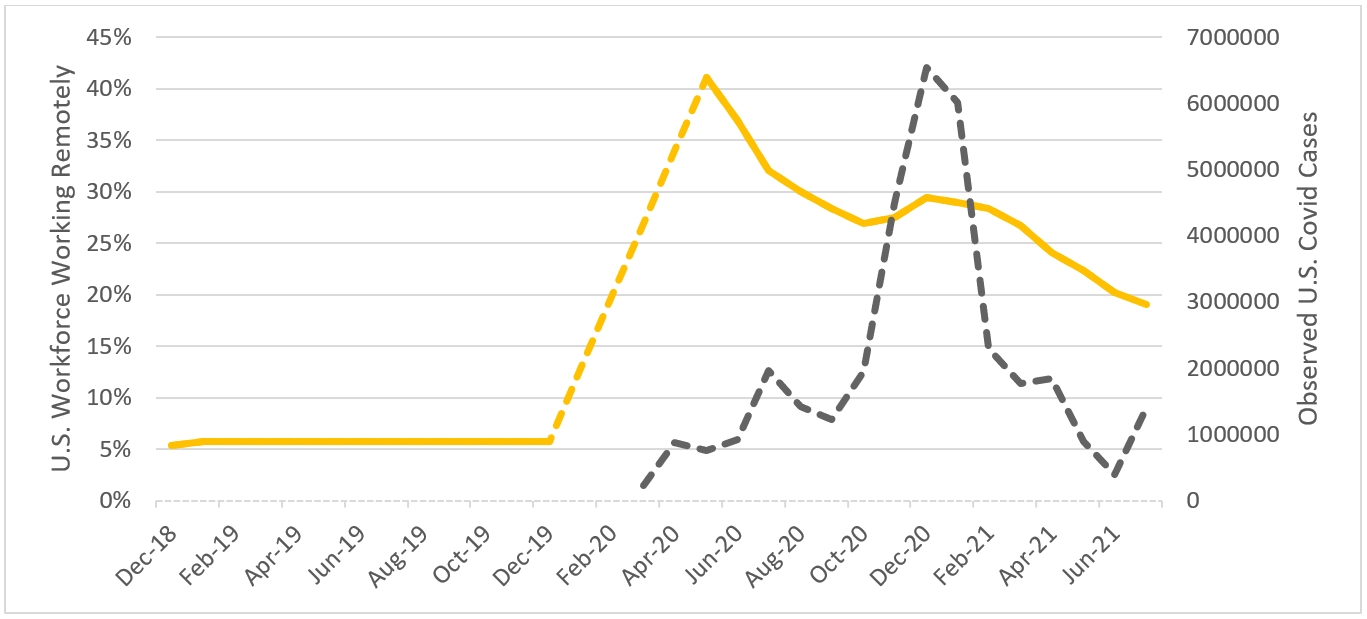More people than ever feel empowered to leave their jobs in favor of better pay and improved working conditions elsewhere. In November 2021, 4.5 million workers quit their jobs, beating out previous records in April, August, and September. We are living in the Great Resignation, where people feel more confident than ever in their ability to find better work somewhere else.
But what do these resignation numbers mean for people with disabilities? Are they able to quit their jobs with the same reckless abandon, confident that they can find work again in a few days? Let’s look at a few industry trends to evaluate the labor market for people with disabilities.
Unemployment is higher for people with disabilities
Before you can look at the current labor market, it helps to take a step back and consider the employment rate before the pandemic. In December 2019, the unemployment rate was a little under four percent. The unemployment rate for people with disabilities was eight percent. More than 24.8 million people with disabilities were unemployed or out of the labor market.
Of those who are unemployed with a disability, 80 percent cite their own disability as a barrier to employment. They also cite a lack of education or training, a lack of transportation, or a lack of special features at their jobs.
Scott Lamar and Naomi Pusch, co-chairs of the Disability Employee Resource Group at the St. Louis Fed, highlighted multiple reasons why people with disabilities have a hard time entering the workplace. Many of these factors are out of the employee’s control:
- While a workplace may be physically accessible, an inaccessible website might prevent a candidate from completing a job application.
- Many disabilities are invisible, which means the needs of workers are ignored or the disability isn’t taken as seriously as a visible one. For example, the needs of someone with anxiety.
- Disabilities are more common in older Americans. As the workforce gets older, the number of employees with disabilities will increase. This couples agism with disability discrimination in hiring.
Many people with disabilities want to work and want to participate in the current competitive hiring market, but simple barriers by the employer (like an inaccessible website) prevent them from finding work.

The pandemic worsened the labor gap
At the start of the pandemic, millions of Americans lost their jobs. However, people with disabilities fared far worse when facing newfound unemployment. Workers with disabilities lost one million jobs, a 20 percent decline. Workers without disabilities only faced a 14 percent employment decline.
As the economy started to rebound, workers with disabilities had a much harder time getting rehired. As noted in the chart below, people with disabilities fall well below their counterparts in getting rehired.

“Recent months have seen some encouraging overall market numbers that would seem to signal an employment rebound,” writes Paula Morgan at Forbes. “However, these numbers are mostly among high-wage earners, with about 20 percent of workers earning less than $27,000 annually still being unemployed. Unfortunately, many workers with disabilities fall into this category.”
While many workers without disabilities are enjoying newfound employment opportunities where they can participate in the Great Resignation until they find a job they are happy with, people with disabilities are still trying to bounce back from the initial COVID-19 unemployment blow.
Employers are better supporting employees with disabilities
Despite the existing labor gap for people with disabilities, there are bright spots that could lead to increased employment opportunities in the future. In December 2021, Adobe shared the results from a survey of 1,000 workers (full-time, part-time, and students) including those with and without disabilities. A few key results include:
- 77 percent of respondents living with a disability felt their workplace has done a better job supporting them since the start of the pandemic.
- 70 percent of people with disabilities feel like their employers provide adequate training around disability etiquette education.
- 77 percent of respondents are interested in learning more about accessibility in the workplace.
While this is just one survey, the results are promising. The responses highlight how employers are starting to care about employees with disabilities and how workers are starting to notice accessibility changes for the better.
Remote work is a win for people with disabilities
One of the biggest trends to come out of the pandemic was the rise in remote work. Pre-pandemic, less than five percent of the workforce was remote. Many companies lacked concrete work-from-home policies and continued to hire people near their office locations. As of June 2021, almost 20 percent of people work remotely at least part-time.

Looking ahead, 80 percent of company leaders say they plan to extend remote work and hybrid (part-time remote work) options beyond the pandemic. While many workers see this as a win for workplace flexibility and better employment conditions, the rise in remote work is seen as an opportunity for people with disabilities.
The Adobe study found that 46 percent of workers check a potential employer’s remote work policy when applying. This jumps to 58 percent for people with disabilities. Remote work eliminates travel barriers for people with disabilities who have difficulty coming into the office. It also allows people to work in a better environment where they can be physically comfortable and control their mental stimuli, like the sounds and smells around them.
Remote work isn’t the only solution
While remote work can benefit the global workforce, it’s not the only solution available to employers looking to accommodate people with disabilities. These workers also want the option of coming into the office and don’t want to feel isolated at home. Furthermore, not every job can be done remotely, which means employers need to take a whole-company look at their accessibility levels.
Many community leaders are calling on employers to continue working on their workplace accessibility, from their hybrid work policies to their online application portals. Leaving people with disabilities out of the workforce does a disservice to the American economy as a whole.
“[People with disabilities] tend to take less sick days than their counterparts without a disability, they tend to stay in that position longer than their counterparts without a disability,” says April Reed, vice president of advocacy for Ability360.
By failing to create inclusive work environments, employers will continue to struggle to hire and retain workers. This includes people with disabilities along with low-income Americans, people with families, and workers with different lifestyles.
You can make your workplace accessible
While you can’t single-handedly solve employment discrimination in America, you can take steps today to make your workplace better for people with disabilities. You can improve your physical accessibility while updating your digital assets. You don’t have to do it alone. We have countless resources to guide you and can help connect you with accessibility business experts who know what you need.




Comments